Home >> Nuclear, exchange particles
explaining fields |
|||
Explaining fields
An electrostatic field is a region around a charged object, where force is applied to another charged object. Similarly a gravitational field is a region around a mass, where force is applied to another mass.
The sizes of the forces involved are dictated by the magnitude of charges, masses and distances.
Now these forces can be calculated quite accurately using the relevant equations, but these equations do not explain what causes the forces.
To answer this question we need to introduce the concept of exchange particles.
Exchange or virtual particles interact with particles to produce the effects of attraction or repulsion. They do this by shuttling back and forth between the particles, carrying small packets of energy.
For repulsion, the effect is much the same as two ice-skaters passing a heavy ball between them. They might start off close together, but as the ball is passed between them, the skaters will diverge from eachother.
Feynman diagrams
Here are the generally accepted rules for drawing the diagrams:
1. particles - straight lines with arrows pointing upwards
2. anti-particles - straight lines with arrows pointing downwards
3. electrons(Electromagnetic Force)- wavy lines
4. gluons(Strong Force) - looped lines
5. bosons(Weak Force) - dashed lines
6. time is measured vertically(sometimes horizontally)
7. space is measured horizontally(sometimes vertically)
8. charge is conserved at each junction
9. baryon number is conserved at each junction
The Strong Force (Interaction)
Sometimes called the Colour Force, the Strong Force is what holds the nucleus together and also withinin each nucleon, the force that holds the quarks together.
The Strong force can therefore be thought of as two forces. So the exchange particles for the nucleus and nucleons are different.
Pions are the exchange particles that hold protons(and neutrons) together in the nucleus.
( πo, π+, π- )
example: proton-neutron interaction
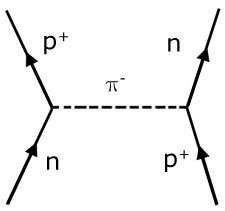
In this case, the Strong Force is called the 'residual' or 'nuclear' force. It is in effect a consequence of the main Strong Force, that holds quarks together in a nucleon.
Gluons (g) are the exchange particles responsible for holding quarks within the confines of individual nucleons. They are termed 'Gauge Bosons' with 8 different types or 'colours'.
The Feyman diagram represents a quark-antiquark annihilation and creation, with gluon exchange.
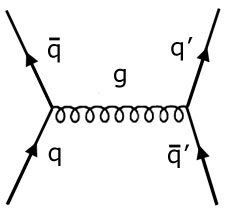
Physics at this level does not require any more on this topic. However, if the Reader wants to explore further, follow this link to an article on gluons from Wikipedia.
Quantum Chromo Dynamics (QCD) is the name given to the branch of physics describing the Strong Force. This in turn is part of what is termed the Standard Model of particle physics.
The Weak Force (Interaction)
A small group of particles called intermediate vector bosons are responsible for metering out the Weak Force.
W+ W- Zo
The W+ boson is involved in the interaction between a neutrino and a neutron creating a proton and an electron.
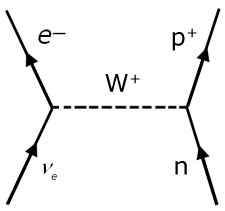
The W- boson is involved in the decay of a neutron into a proton, an electron and a neutrino.
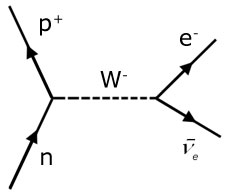
What really happens within a nucleon is that the Weak Force changes a 'd' quark into a 'u' quark. The structure thus changes from 'udd'(a neutron) to 'uud'(a proton). At the point of change a W- particle is emitted, which promptly decays into an electron and an electron anti-neutrino.
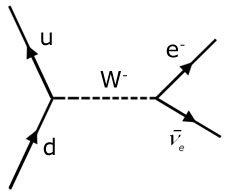
The Zo boson is involved in collisions between particles, where there is no transfer of charge.
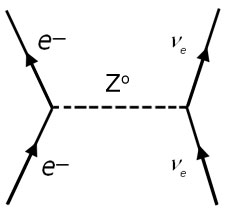
The Electromagnetic Force (Interaction)
Electromagnetic Force is the the interaction between electrically charged particles. The sphere of influence of the force is manifest in what we call the electromagnetic field (both electrostatic & magnetic).
The exchange particle for the electromagnetic force is the virtual photon (γ gamma).
Here a virtual photon is exchanged between two electrons causing them to repel.
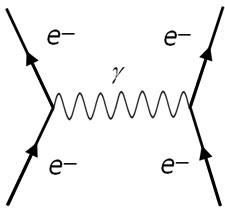
The closer the electrons approach eachother, the shorter the virtual photon wavelength becomes.
Gravitational Force (Interaction)
The graviton (G) is the exchange particle for the Gravitational Force. The graviton was first observed in 2016.
Here are the inferred properties of the exchange particle:
1. gauge boson (like W+ W- Zo )
2. rest mass - zero
3. electronic charge - zero
4. spin = 2
[ About ] [ FAQ ] [ Links ] [ Terms & Conditions ] [ Privacy ] [ Site Map ] [ Contact ]
